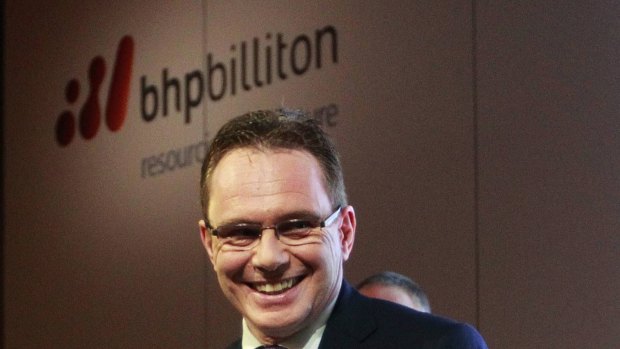By Malcolm Maiden
BHP Billiton says that the silver, nickel, manganese, alumina/aluminium and energy coal businesses that it intends to spin out to shareholders by way of a demerger are among the world’s most attractive resources assets.
They are not as attractive as the ones BHP is keeping, however, and that is why BHP is spinning them out.

BHP Billiton chief executive Andrew Mackenzie says the assets set to be demerged are 'built to BHP standards'. Credit: Reuters
BHP says in its announcement that the assets that are being demerged are expected to generate an average annual return of more than 20 per cent.
That's a good return. By way of comparison, CBA, one of the world's most profitable banks, posted a return on equity of 18.7 per cent in the year to June 30.
BHP chief financial officer Graham Kerr will run the new listed company, and he says that over the past decade, the demerged assets have on average produced revenue of about $US10 billion a year, and average earnings before interest, tax, depreciation and amortisation of about $3.3 billion.
The huge businesses that BHP is keeping - iron ore, coking coal, petroleum and copper – are even better.
They are bigger, and they are lower cost. The assets that are being hived off are also towards the bottom of the global cost curve, but they are not as far down as the ones BHP is keeping. With petroleum still in the mix, BHP also continues to own a business that smoothes out the mining commodity price cycle.
BHP says that in the year to June the businesses that are being retained would have kept 42¢ in every dollar of sales as earnings before interest and tax - above the demerged portfolio's return of about 34 per cent in the last decade, and well above the demerged portfolio's return of 21 per cent in the latest year to June.
Still, the break up should be a winner for BHP shareholders. The assets being spun out are smaller than the ones BHP is keeping "but they are built to BHP's standards," BHP chief executive Andrew Mackenzie says.
An insight into BHP's thinking is that the new listed company will be relatively low geared, with debt of just over $US1 billion.
Another is that BHP has decided against loading its problematic Nickel West business in Australia into the demerged vehicle, preferring instead to separately market it for a trade sale.
BHP lifted annual dividend by 4 per cent in the year to June, and while it didn't talk about BHP-specific capital initiatives, it clearly sees the demerger as a significant one in its own right.
The assets being demergedBHPBHPdemerger
The assets being demergedBHP, putting the new company in a position to pay dividends in its own right that will supplement the ones that BHP
Cynics will of course describe the demerger proposal as the final undoing of BHP's merger with Billiton in 2001. Roughly half the assets that are going into the demerged vehicle came to BHP in that marriage.
The key though is that BHP has consciously put together a portfolio of assets for the new listed company that are sub-scale for a business of its size, but strong enough for shareholders and the market to accept.
With low gearing, separate management led by Kerr and a separate board chaired by outgoing BHP director David Crawford, the new company will in the medium-term be contemplating expansion through mid-sized acquisitions that inside BHP would, if proposed, almost certainly have been too small to win support.
BHP, meanwhile, will be focused on its very best properties, and will still be less exposed to the iron ore price than its biggest competitor, Rio Tinto, which sourced almost three-quarters of its earnings before interest, tax, depreciation and amortisation in the June half-year from the Pilbara.
Unlike Rio Tinto, the slimmed-down BHP will also continue to own a significant petroleum business that tends to run to a different price cycle to mining.
Lower dependence on the iron ore price and additional exposure to the oil price can be a positive or a negative on what way prices for those two commodities are moving of course, but there are many investors who like the "smoothed' commodity price cycle business that BHP has developed, and is going to retain.